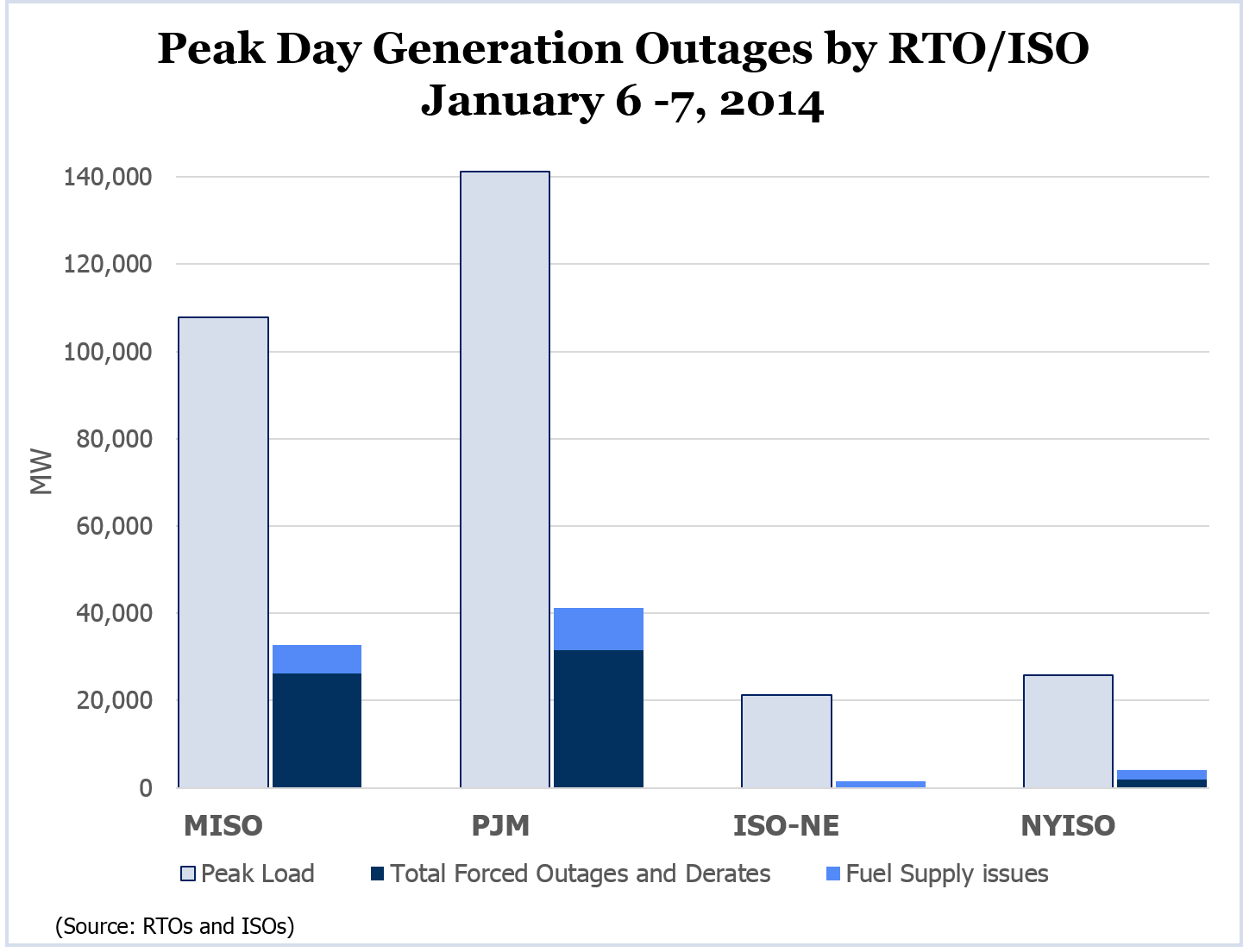By William Opalka, Chris O’Malley and Rich Heidorn Jr.
The National Oceanic and Atmospheric Administration says this winter will be 12% warmer than last winter. So why aren’t grid operators jumping for joy?
Maybe because NOAA never saw the polar vortex coming.
The operational challenges presented by last winter’s severe cold has led grid operators from the Midwest to New England to institute winter generator testing, fuel stockpiling and increased communications with natural gas pipelines.
But the reliability cracks that became so apparent last winter are more than a function of the polar vortex. Last winter exposed long-term challenges that will take years to address, from the industry’s growing dependence on volatile and often scarce natural gas, to the market trends threatening the viability of nuclear generation and what some critics say is an overreliance on renewables and demand response.
So RTO and ISO officials’ answers to the question “Are you ready for the coming winter?” are cautiously optimistic at best — some more cautious than others.
PJM spokesman Ray Dotter told RTO Insider the RTO should have adequate power supplies “based on [weather] forecasts.”
NYISO spokesman David Flanagan declared that the ISO is “well prepared.”
Eric Callisto, president of the Organization of MISO States (OMS) and a member of the Wisconsin Public Service Commission, told the Federal Energy Regulatory Commission last month that “there has been an appropriate response in the MISO footprint” to the challenge of tightening reserve margins.
ISO-NE spokeswoman Marcia Blomberg painted the least rosy picture, saying New England will be in a “precarious operating position for the next several winters.”
While the likelihood of a repeat of last winter — the coldest in 20 years — is unlikely, there is no uncertainty about the trends facing RTO and ISO officials as they head into this winter.
Pipeline growth is not keeping up with the increasing dependence of the electric industry on natural gas, and most of the gas-fired capacity lacks firm-fuel contracts.
And while most of the coal-fired generation that helped prevent disaster in 2014 will remain in operation for the coming winter, an estimated 15,000 MW will be gone by winter 2016/17. PJM said plants scheduled for retirement had outage rates of 40% to 50% because of a lack of operations and maintenance spending.
Meanwhile, RTOs aren’t sure they’ll be able to count on demand response in the future as a result of the D.C. Circuit Court of Appeals’ decision throwing out FERC Order 745. (See Awaiting FERC Action, PJM Floats ‘Trial Balloon’ on DR Post-EPSA.)
FERC Commissioner Philip Moeller has been vocal about his concerns, saying grid operators have to assume the coming winter will be as bad as last year’s. He has called for exposing consumers to real-time prices as a way to reduce peak-demand stresses — a call that few state regulators have rushed to embrace.
“I think we should brace ourselves, particularly after the AccuWeather forecast from yesterday,” Moeller said at last week’s commission meeting.
AccuWeather’s annual winter forecast, released Oct. 15, predict a polar vortex will occasionally return to the Northeast in January and February, although the cold is not expected to be as prolonged. Higher-than-normal snow totals are forecast west of the I-95 corridor. The forecast predicts the Midwest will see below-normal snowfall and temperatures as much as 7 degrees warmer than last year.
“This winter was an example of the very thing that keeps me up at night,” Donald Schneider, president of FirstEnergy Solutions, told a FERC technical conference in April. “How did we, as regulators and operators responsible for keeping the lights and heat on for our customers, get to a place where we were nearly 500 MW away from depleting all synchronized reserves on the [PJM] system?”
In a June article in Public Utilities Fortnightly, ICF consultant Judah Rose warned that last winter might be a harbinger of a “new normal.”
“What the polar vortex brought to light is that we have had a distorted view of system capacity due to market rules and regulatory assumptions from [FERC] that have failed to properly value (or consider) reliability,” he wrote.
In addition to challenges wrought by the shift from coal to natural gas, Rose blames what he calls “overly optimistic expectations” for the winter contributions of demand response and renewables.
In addition to raising reliability concerns, last winter also boosted costs dramatically. Because of gas purchasing schedules, PJM was forced to run high-cost gas generators through the entire Martin Luther King Jr. holiday weekend to ensure their availability the following Tuesday morning. The combination of heating and power demand led to spikes in gas and electricity prices, forcing a few retail marketers into default and quadrupling bills for many retail electric customers with variable rate plans.
“Last winter, reliability was sustained but at very high cost,” FERC Chairman Cheryl LaFleur said last week.
Maryland Public Service Commissioner Lawrence Brenner is among those who cautions against responding to the challenges with a pipeline- and generation-building spree, saying reliability needs must be balanced against costs. Instead, he said RTOs should redouble their efforts to improve the coordination of energy and capacity across seams.
Winter Reliability Standard?
A commission review of the 2011 Southwest cold snap recommended the North American Electric Reliability Corp. consider a winter reliability standard.
Although NERC has issued winter readiness guidelines, FERC staff told the commission last week that “there has not been any movement on new standards.”
Asked in a press conference after the commission meeting whether she supports a winter standard, LaFleur also cited cost concerns. “I’d want to think about it a little more before I take a position,” she said.



